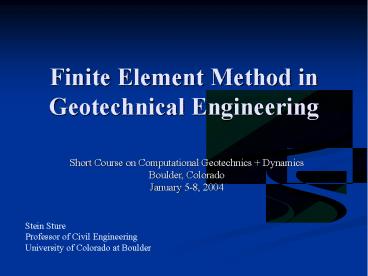Finite Element Method in Geotechnical Engineering - PowerPoint PPT Presentation
Title:
Finite Element Method in Geotechnical Engineering
Description:
Finite Element Method in Geotechnical Engineering Short Course on Computational Geotechnics + Dynamics Boulder, Colorado January 5-8, 2004 Stein Sture – PowerPoint PPT presentation
Number of Views:580
Avg rating:3.0/5.0
Title: Finite Element Method in Geotechnical Engineering
1
Finite Element Method in Geotechnical Engineering
- Short Course on Computational Geotechnics
Dynamics - Boulder, Colorado
- January 5-8, 2004
Stein Sture Professor of Civil Engineering Univers
ity of Colorado at Boulder
2
Contents
- Steps in the FE Method
- Introduction to FEM for Deformation Analysis
- Discretization of a Continuum
- Elements
- Strains
- Stresses, Constitutive Relations
- Hookes Law
- Formulation of Stiffness Matrix
- Solution of Equations
3
Steps in the FE Method
- Establishment of stiffness relations for each
element. Material properties and equilibrium
conditions for each element are used in this
establishment. - Enforcement of compatibility, i.e. the elements
are connected. - Enforcement of equilibrium conditions for the
whole structure, in the present case for the
nodal points. - By means of 2. And 3. the system of equations is
constructed for the whole structure. This step
is called assembling. - In order to solve the system of equations for the
whole structure, the boundary conditions are
enforced. - Solution of the system of equations.
4
Introduction to FEM for Deformation Analysis
- General method to solve boundary value problems
in an approximate and discretized way - Often (but not only) used for deformation and
stress analysis - Division of geometry into finite element mesh
5
Introduction to FEM for Deformation Analysis
- Pre-assumed interpolation of main quantities
(displacements) over elements, based on values in
points (nodes) - Formation of (stiffness) matrix, K, and (force)
vector, r - Global solution of main quantities in nodes, d
- d ? D ? K D R
- r ? R
- k ? K
6
Discretization of a Continuum
- 2D modeling
7
Discretization of a Continuum
- 2D cross section is divided into element
- Several element types are possible (triangles and
quadrilaterals)
8
Elements
- Different types of 2D elements
9
Elements
Example
- Other way of writing
- ux N1 ux1 N2 ux2 N3 ux3 N4 ux4 N5 ux5
N6 ux6 - uy N1 uy1 N2 uy2 N3 uy3 N4 uy4 N5 uy5
N6 uy6 - or
- ux N ux and uy N uy (N contains
functions of x and y)
10
Strains
- Strains are the derivatives of displacements.
In finite elements they are determined from the
derivatives of the interpolation functions - or
- (strains composed in a vector and matrix B
contains derivatives of N )
11
Stresses, Constitutive Relations
- Cartesian stress tensor, usually composed in a
vector - Stresses, s, are related to strains e
- s Ce
- In fact, the above relationship is used in
incremental form - C is material stiffness matrix and determining
material behavior
12
Hookes Law
- For simple linear elastic behavior C is based on
Hookes law
13
Hookes Law
- Basic parameters in Hookes law
- Youngs modulus E
- Poissons ratio ?
- Auxiliary parameters, related to basic
parameters - Shear modulus
Oedometer modulus - Bulk modulus
14
Hookes Law
- Meaning of parameters
- in axial compression
- in axial compression
- in 1D compression
axial compression
1D compression
15
Hookes Law
- Meaning of parameters
- in volumetric compression
- in shearing
- note
16
Hookes Law
- Summary, Hookes law
17
Hookes Law
- Inverse relationship
18
Formulation of Stiffness Matrix
- Formation of element stiffness matrix Ke
- Integration is usually performed numerically
Gauss integration -
(summation over sample
points) - coefficients ? and position of sample points can
be chosen such that the integration is exact - Formation of global stiffness matrix
- Assembling of element stiffness matrices in
global matrix
19
Formulation of Stiffness Matrix
- K is often symmetric and has a band-form
-
(
are non-zeros)
20
Solution of Equation
- Global system of equations
- KD R
- R is force vector and contains loadings as
nodal forces - Usually in incremental form
- Solution
-
(i step number)
21
Solution of Equations
- From solution of displacement
- Strains
- Stresses































